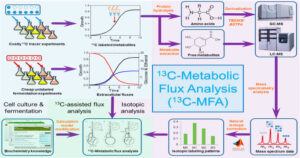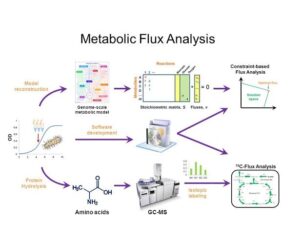Back to: MICROBIOLOGY 200 LEVEL
Welcome to class!
Hello brilliant star! Welcome once again to your Afrilearn microbiology journey. I’m super proud of how far you’ve come! Today, we’ll be talking about something very important in microbial metabolism—Metabolic Flux. Don’t worry if that sounds a little technical. You’ll see it’s actually something very logical and easy to relate to once we break it down together in our good old Nigerian way. Let’s go!
Metabolic Flux
What is Metabolic Flux?
Metabolic flux simply means the rate or speed at which molecules move through a metabolic pathway. In other words, it tells us how fast cells are carrying out chemical reactions to convert one molecule into another.

Think of it like the traffic flow in Lagos. If the roads are free, cars move fast—high traffic flow. But if there’s a go-slow or blockage, movement becomes slow—low traffic flow. That’s how metabolic flux works in a cell. It tells us how “free” or “blocked” the cell’s chemical roads (pathways) are.
Why Is It Important?
In microbial cells (and all living cells), many complex reactions are always going on—breaking down food, building up proteins, making energy, and more. The cell needs to control these reactions so it doesn’t overwork or waste resources.
By controlling the metabolic flux, cells can:
Balance how much energy they use or save
Control how much of a product they need to make
Decide which pathway to focus on depending on the environment
What Affects Metabolic Flux?
Several things can increase or reduce metabolic flux, just like traffic conditions affect driving speed. These include:
Enzyme Activity – If enzymes are very active, reactions go faster.
Substrate Availability – If there’s enough starting material (like glucose), the pathway can proceed faster.

Product Build-Up – If there’s too much end-product, the cell may slow things down (feedback inhibition).
Energy Levels (ATP/ADP ratio) – If the cell has enough energy, it may reduce the speed of energy-producing pathways.
Environmental Conditions – Like temperature, pH, or oxygen levels.
Real-Life Analogy
Let’s say your mum is cooking party jollof rice. The flux in the kitchen depends on:
How many ingredients are available (substrate),
How fast she chops, stirs, and cooks (enzyme activity),
Whether there’s enough gas or electricity (energy supply),
And whether the rice is finished or still plenty (product feedback).
If everything is working smoothly, the cooking moves fast—high flux!
Why Should You Care?
Understanding metabolic flux helps scientists:

Design better drugs to target harmful microbes
Improve fermentation processes (like making yoghurt or alcohol)
Control microbial behaviour in biotechnology or environmental clean-up
Summary
- Metabolic flux is the rate of flow of molecules through a metabolic pathway.
- It helps the cell regulate and balance how it uses resources.
- Flux is affected by enzyme activity, substrate supply, energy levels, and environmental conditions.
Evaluation
- What is metabolic flux in simple terms?
- Mention two factors that can increase metabolic flux.
- How does feedback inhibition affect metabolic flux?
- Why is metabolic flux important in microbiology?
Great work today, champ! You’ve just tackled a key concept that helps explain how life stays organised, smart, and efficient. With Afrilearn, you’re not just learning—you’re mastering life-changing science that puts you steps ahead. Keep believing in yourself. You’ve got this, and we can’t wait to see you shine even brighter in the next lesson!
